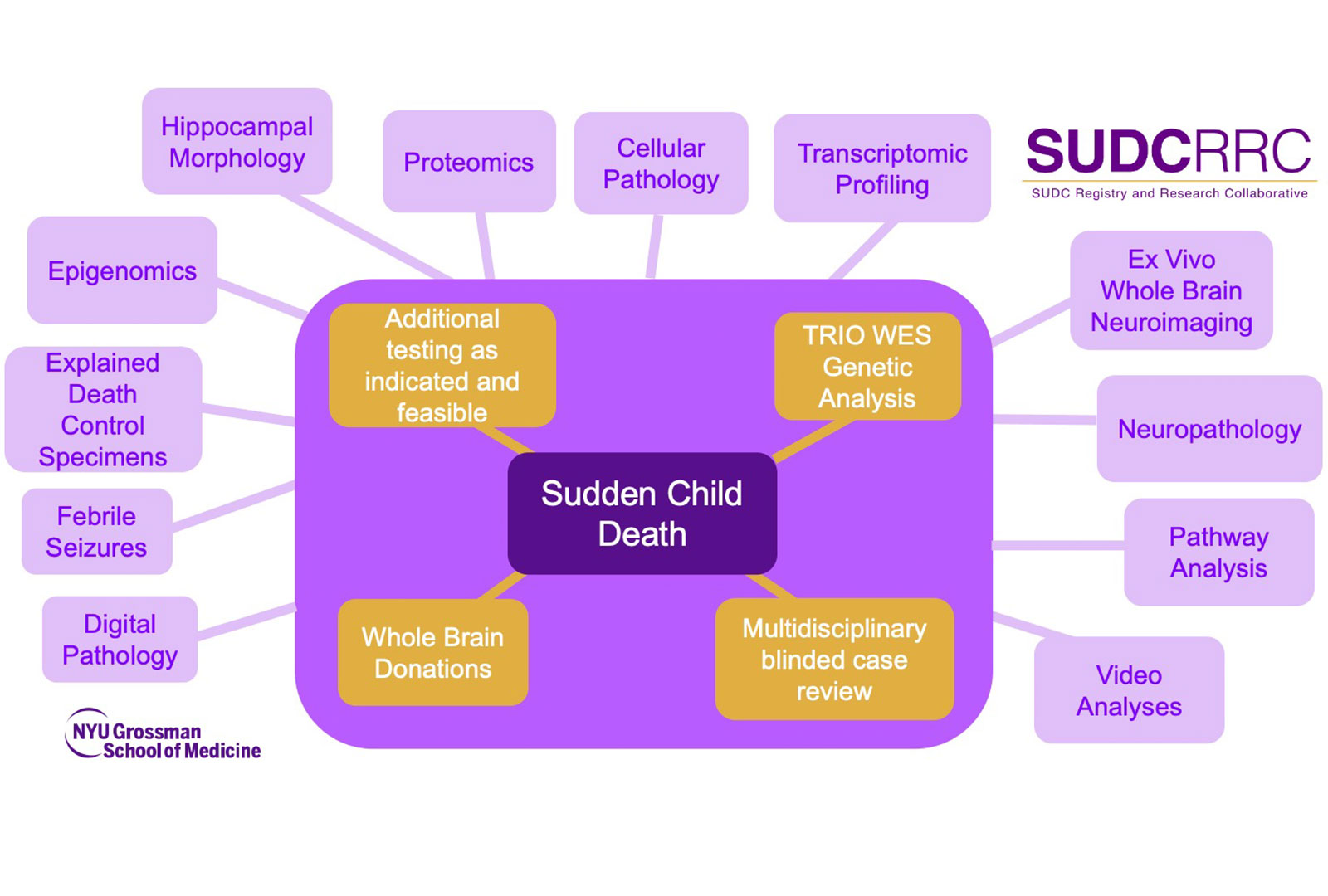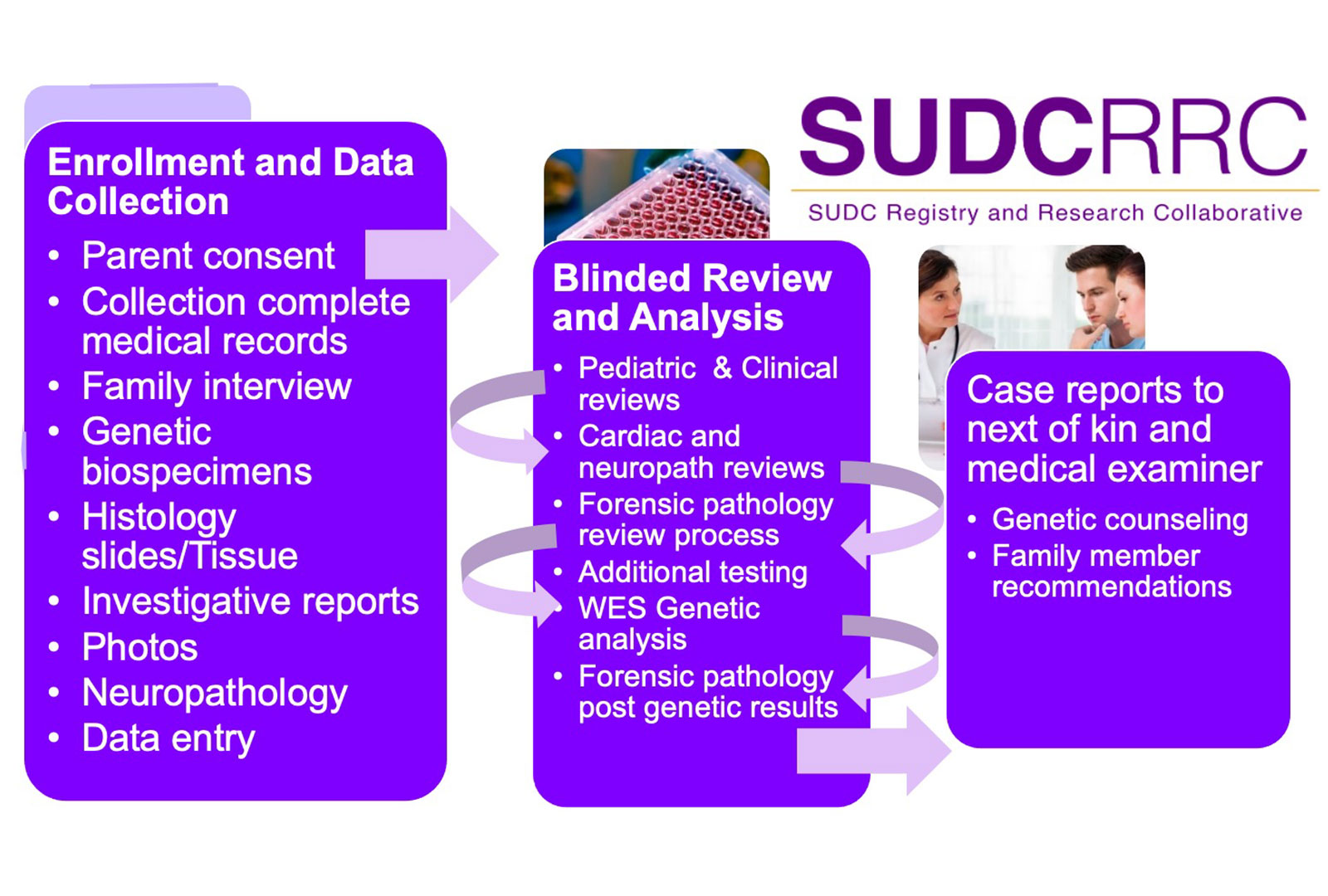
How the Sudden Unexplained Death in Childhood Registry & Research Collaborative Works
Researchers at NYU Langone’s Sudden Unexplained Death in Childhood Registry and Research Collaborative (SUDCRRC) are involved in transformative scientific work. We encourage other scientists and families affected by sudden unexplained death in childhood (SUDC) to learn more about our research efforts.
The Importance of Research on Sudden Unexplained Death in Childhood
Currently, SUDC is neither predictable nor preventable. Research improves our understanding of sudden deaths in children and impacts our ability to prevent them. At the SUDCRRC, we study each child in detail and draw on the expertise of our many team members to gain insights that go beyond individual research efforts. Each multidisciplinary case review of a child teaches us and fosters new research questions and subsequent experiments. We are grateful to the families who allow us to learn from their life’s biggest tragedy. Our common goal is to understand and prevent SUDC.

Professional Program Referral and Child Enrollment
A family, or professional who is referring a family, can reach out to us at SUDCRRC@NYULangone.org or 646-754-2230. A study team member then makes contact. If the child satisfies all enrollment criteria and the parent or parents agree to enrollment, we mail the parents all study enrollment forms, schedule an enrollment call, and answer any questions they may have.
Enrollment Costs Are Covered by Grants and Donations
Families and professionals do not incur any costs for study participation. Help support continued advances at the SUDCRRC
Informed Consent, Enrollment, and Case Review Process
Study participation first involves completing the informed consent process. This includes completing consent forms and authorizations for release of medical information. This is completed by phone or video call with Laura A. Gould, MSc (co-principal investigator and research assistant professor) to ensure that all questions are addressed, and that the family understands their decision.
Once enrolled, the parents complete a family interview, and biological parents are asked to provide a blood sample for genetic analysis. In parallel, study team members collect the child’s medical records, and work with the medical examiner or coroner for information and specimens needed to start our research and multidisciplinary review process.
If parents’ consent to receive results back from the study, study team members contact parents as soon as they are available. Time for results vary for each investigation. Families are usually in active participation with us for a few years.
The case review process is summarized below:

Growing Awareness of Sudden Unexplained Death in Childhood
SUDC was first defined in 2005 (Krous et al., 2005, Pediatr Dev Pathol). Prior to 1989, most SUDC toddler-aged deaths would likely have been considered sudden infant death syndrome (SIDS). Annually, more than 450 children in the United States, aged 1 to 18 years, are affected by unexplained deaths. Rates of SUDC are similar in the United Kingdom, and likely elsewhere. Awareness and research have been limited but are growing. Participation in the SUDCRRC enables us to learn and helps the medical community to prevent such deaths in the future.
Sudden Unexplained Death in Childhood Differs from Sudden Infant Death Syndrome
By definition, SUDC is different from sudden infant death syndrome (SIDS) by age. Sudden infant death syndrome is characterized by the unexplained death of an infant under the age of 12 months, while SUDC is characterized as those deaths occurring between 12 months and 18 years of age that are unexplained after thorough investigation.
SUDC is distinct from SIDS by a comparative paucity of research and funding. In recent decades, SIDS research has been allocated more than $500 million in public funding, while no targeting funding for SUDC has occurred in same time period (NIH Estimates of Funding for Various Research, Condition, and Disease Categories, 2024). SIDS cases have declined significantly since 1990 from 130.3 death per 100,000 births to 41.7 deaths per 100,000 births in 2022 (CDC Data and Statistics for SUID and SIDS, 2022).
Funding for Our Collaborative
The SUDCRRC is supported by sponsors including NYU Langone’s FACES, scientific grants, and private donations. Additional research funds are crucial to advance SUDC research and stop these tragedies. If you would like to support our efforts, please donate. You can also learn about additional ways to help support the SUDCRRC.
About Us

Support Our Research
